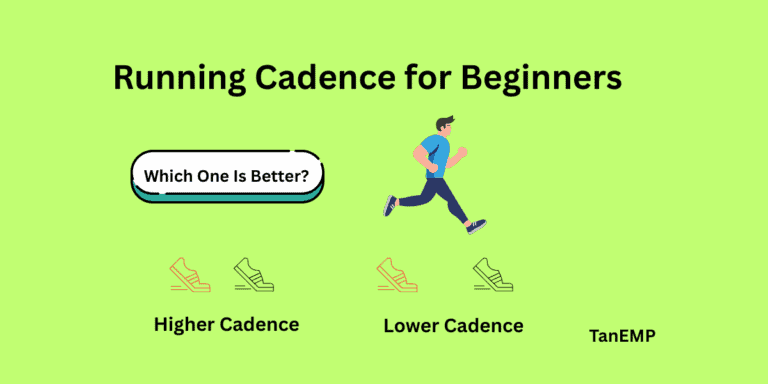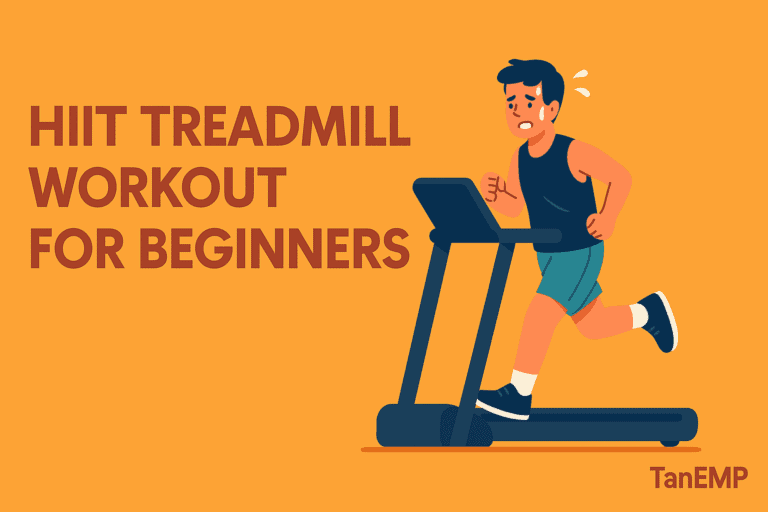Proper Running Form For Beginners: A Guide To Avoid Injury in 2025
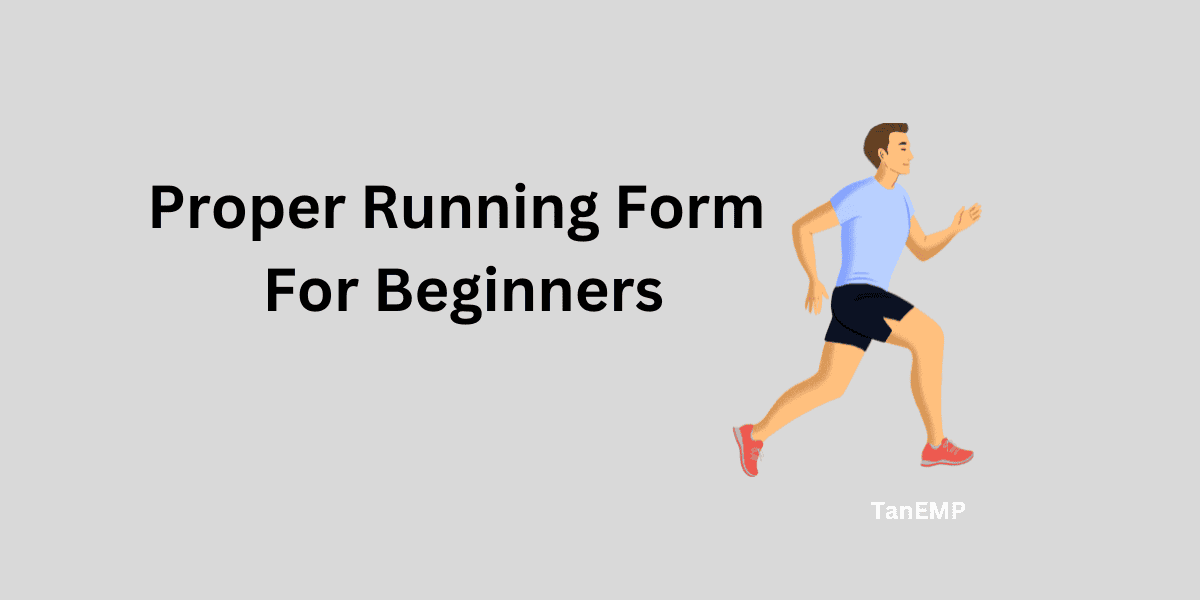
Running seems simple, right? Just put one foot in front of the other!
According to a study from the Journal of Orthopaedic & Sports Physical Therapy, as many as 79% of all runners will sustain an injury related to running, which may be due to poor running form.
Whether you’re a brand new runner or looking to improve your technique, mastering proper running form can transform your running experience.
As a chiropractor who works with many runners, I will include a comprehensive guide that breaks down everything you need to know about running technique, from head to toe. This guide will help you become a more efficient, injury-resistant runner!
Key Takeaways for Proper Running Form
- Start With Alignment: Proper running form begins with a relaxed body. Keep your head steady, shoulders relaxed, and maintain a slight forward lean for efficient movement.
- Breathe Smartly: Use diaphragmatic breathing to improve running economy and lower your center of gravity to improve balance during long or short runs.
- Use Arm Swing Efficiently: Swing your arms naturally at a 90-degree angle, moving front-to-back, not across your body, to conserve energy and maintain momentum.
- Mind Your Stride and Cadence: Aim for a shorter stride with 170–180 steps per minute to reduce impact and run more efficiently.
- Focus on Foot Strike and Lower Body Mechanics: Land softly under your hips for proper alignment, whether you heel, midfoot, or forefoot strike. Pair this with a good pair of running shoes for quick, light steps to minimize ground contact and improve forward motion, reducing strain on your lower body.
- Focus on Injury Prevention: Gradual training, strength exercises for key muscles, and proper foot placement (midfoot or light landings) can help avoid common injuries and keep you running strong.
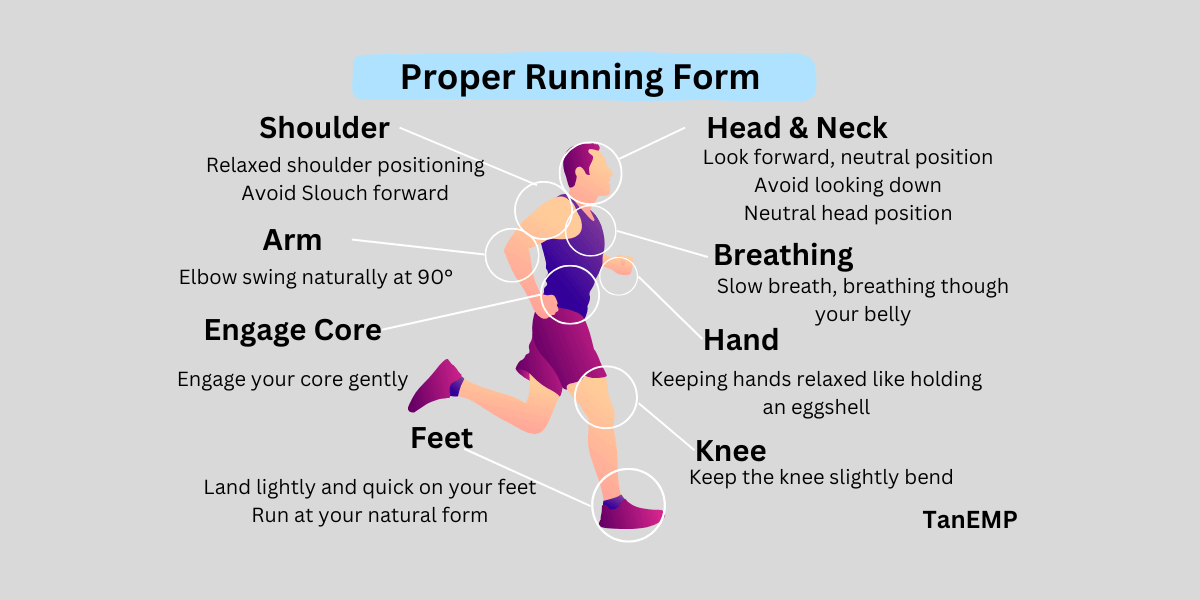
What is the Proper Running Form?
Do you know what I tell most new runners when they ask me about good running form?
“Keep it natural!”
I’ve seen too many beginners get caught up trying to copy elite runners’ techniques right from the start. Your body needs time to adapt to running, and forcing an unnatural form can actually cause more harm than good.
That said, running naturally doesn’t mean ignoring proper running technique completely. There are some basic elements that can help prevent injury and make your runs more enjoyable. Think of it like learning to dance – start with the basic steps before trying those fancy moves!
Before you hit the road, there are a few key tips that can help improve your running without overwhelming you. Ready to learn how to become a stronger runner while staying comfortable?
Let’s dive into the details!
Similar Post: How To Start Running
Mastering Running Posture: From Head to Toe
1. Head and Neck Position Running form

Many rookies tend to stare at their feet while running. Staring at your feet already puts you at the disadvantage of leaning forward, and increases strain on your upper body.
Worse case, you may run into someone or something in a big city like NYC.
Your running form starts right at the top with your head and neck position. Think about holding your head like you’re trying to keep a baseball cap level (not tilted down or craning back).
Look about 15-20 feet ahead of you, as if you’re anticipating what’s coming.
This natural head position helps keep your whole body aligned properly, making your runs feel way more comfortable.
Keeping your head steady also helps maintain good posture and prevents that nasty neck tension that used to creep up on me during longer runs. Trust me, your neck will thank you later!
2. Breathing Techniques for Runners
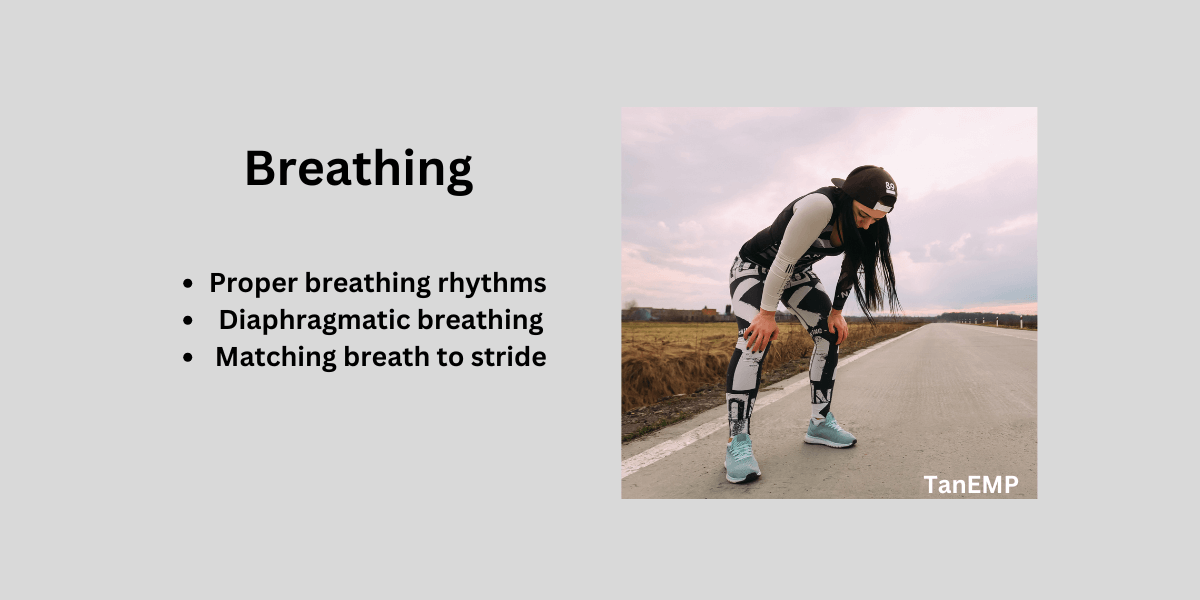
Breathing properly while running is more important than most beginners realize.
Advantages of belly breathing:
- Increase oxygen intake
- Slow down your heart rate slightly to avoid excessive breathing
- Lower center of gravity by involving your core muscles
Belly breathing, also known as diaphragmatic breathing, helps improve your oxygen intake by engaging the diaphragm instead of shallow chest breaths.
This technique not only provides more energy but also lowers your center of gravity by involving core muscles, improving stability, and reducing strain on your body.
Another advantage of belly breathing is its ability to slow your heart rate slightly, preventing that panicky, gasping feeling from excessive breathing.
To practice:
- Inhale deeply for two steps
- Allowing your belly to rise
- exhale for another two steps.
For higher intensity, adjust to shorter breathing patterns like in for two, out for one.
The key is consistency.
Deep, steady breaths keep you relaxed and aligned, helping you maintain forward motion efficiently without unnecessary energy loss.
Practicing this off the track while lying down on your back can make adapting to this technique much easier when running.
3. Upper Body Mechanics
Runners often overlook their upper back because they focus more on their lower body. But tightness in the upper back is super common. I see it all the time in my clinic, along with tight hips, hamstrings, and calves.
Bad upper body mechanics can throw off your rhythm. When this happens, you burn more energy and tire out faster.
Here are a few tips to improve your upper body form:
- Relax your shoulders and keep them down.
- Avoid hunching your shoulders forward.
- Keep an upright posture with a slight forward lean, like a string is gently pulling your chest forward.
Don’t forget your core! Think of it as your natural weight belt, keeping your body balanced and steady so you don’t fall forward.
When your shoulders are loose, your core is engaged, and you’ve got that slight lean, running feels smooth and almost effortless!
4. Good Arm Swing /Arm and Hand Positioning
A good arm swing and relaxed hands are just as important as keeping proper upper body form.
Your arms should swing naturally at about a 90-degree angle at the elbows. Make sure your motion goes front to back and not across your body. This keeps your momentum moving forward efficiently.
Don’t clench your hands.
Think of holding a potato chip you don’t want to crush. This keeps tension out of your upper body and saves energy.
When you pair a proper arm swing with relaxed shoulders and a light grip, running feels easier. You’ll conserve energy and stay strong for longer distances.
5. Lower Body and Foot Strike

Don’t stress about having perfect form in the beginning. Focus on running naturally and getting comfortable. You can always fine-tune your technique later.
- Foot Strikes:
- Some runners land on their heels, while others use a midfoot or forefoot strike.
- All methods can work, but it’s important to land softly to avoid hard impact.
- Stride Length:
- Keep your strides short and controlled.
- Your feet should land under your hips, not far out in front.
- Overstriding is a common cause of bad form and injuries.
- Running Cadence:
- Aim for a cadence of about 170–180 steps per minute.
- A steady cadence improves efficiency and reduces the impact on your body.
Finally, focus on light, quick steps to minimize ground contact time. The less time your feet spend on the ground, the smoother and more energy-efficient your run will be.
These small adjustments can make running feel easier and help prevent injuries.
Common Running Form Mistakes to Avoid
Running with good technique takes practice, but knowing what to avoid can save you a lot of trouble.
- Posture matters: Don’t lean too far forward or backward. It throws off your balance, disrupts forward motion, and can lead to injuries.
- Avoid overstriding: Make sure your feet don’t land too far ahead of your hips. Overstriding increases impact and slows you down.
- Relax your upper body: Keep your shoulders loose and your hands relaxed, like you’re holding a feather. Tension wastes energy you could use for running.
- Breathe steadily: Focus on consistent, steady breathing. This keeps you energized and helps you stay in rhythm, making your runs feel smoother.
Preventing Injuries Through Proper Running Form
Avoiding injuries starts with knowing where problems usually happen. Common trouble spots include your knees, IT bands, ankles, heels, and arches. Poor running form can cause repetitive strain in these areas, turning small aches into big issues.
Take your time with training. Gradual progress is important. Pushing yourself too hard too soon can lead to injuries.
Add strength exercises to your routine. Focus on muscles like your glutes, hip flexors, and calves. Stronger muscles support proper running form and reduce strain.
If the pain doesn’t go away or your form feels off, see a physical therapist or chiropractor for a gait analysis. They can pinpoint and fix any issues to help you run strong and stay injury-free.
Conclusion:
Mastering proper running form is a journey that improves performance and reduces injury risk. Focus on gradual improvements, like maintaining a slight forward lean, a consistent running cadence, and relaxed hands for efficiency.
Remember to incorporate strength training and listen to your body to avoid bad form and overuse injuries. With practice, you’ll run smoother and stronger. Every step you take is a progress of getting better. Stay consistent and enjoy the process!
FAQ on Proper Running Form For Beginners
How to correct the running form for beginners?
Start with a slight forward lean, keep your hands relaxed, and aim for a midfoot strike to reduce impact.
How should a beginner start running?
Begin gradually with short distances and focus on a steady running cadence around 170–180 steps per minute.
How should feet hit the ground when running?
Land softly under your hips for proper alignment and efficient forward motion.




